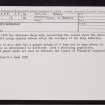North Ronaldsay, Sheep Dyke And Associated Punds
Dyke (19th Century), Pen(S) (19th Century), Sheepfold(S) (19th Century)
Site Name North Ronaldsay, Sheep Dyke And Associated Punds
Classification Dyke (19th Century), Pen(S) (19th Century), Sheepfold(S) (19th Century)
Canmore ID 3647
Site Number HY75SE 56
NGR HY 76499 54021
Datum OSGB36 - NGR
Permalink http://canmore.org.uk/site/3647
- Council Orkney Islands
- Parish Cross And Burness
- Former Region Orkney Islands Area
- Former District Orkney
- Former County Orkney
HY75SE 56 76499 54021
This site also falls on map sheets and HY75SW: the majority falls on HY75SE.
In 1832 the drystone sheep dyke encircling the island above the shore line was built using surplus labour after the collapse of the kelp industry.
The 12 mile dyke has a proper height of 6 feet but in many places it is now less as maintenance is difficult with a declining population.
Red paint marks are used to indicate the limits of 'Funship' responsibilities.
Visited R G Lamb 1979
12-13 mile-long, roughly 6 foot high drystone island perimeter wall, incorporating numerous window-like openings; associated stone-built circular-plan 'punds' situated to N around Dennis Head.
The sheep dyke around North Ronaldsay is a unique and important structure, probably the largest drystone construction conceived of as a single entity in the world. Ownership of sheep was common with crofters being allocated numbers according to the size of the smallholding. The dyke was designed to keep the sheep, for the majority of the year, on the foreshore where they would 'graze' on seaweed. The nine circular 'punds', or pens, which can be found at the north end of the island served a particular purpose. 'Punding' was carried out six times a year as a communal exercise, in order to complete tasks related to the upkeep and organisation of the flock. (Historic Scotland)
Field Visit (September 1979)
Until c.1832 the North Ronaldsay sheep had virtually the run
of the island and caused great damage by getting in among crops,
but in that year the drystone sheep dyke, which encircles the
island above the shoreline, was completed. Surplus labour
resulting from the collapse of the kelp industry is said to have
been used. The common grazings outwith the dyke are operated
using 9 punds. The dyke is 12 miles long and its proper height
6ft, but in many places now less. Maintenance is the
responsibility of the man holding lands in the tunship adjoining
each stretch of the dyke, and in places red-paint marks are used
to indicate the limits of tunship responsibilities. Great
difficulty is now being found in maintaining the length of the
dyke to the proper standard, on account of the declining
population, and the stretches most exposed to sea damage are
seldom rebuilt to the original height.
Information from Orkney SMR (RGL) Sep 79.
Note (1980)
Sheep Dyke and Punds, North Ronaldsay HY75NE & SE
The sheep dyke was created c. 1832, it is said, using surplus labour after the collapse of kelping. Common grazing outwith the twelve-mile dyke is controlled using nine folds or punds; maintenance responsibility is apportioned according to tunship, but with the reduced population there is now difficulty in keeping the dyke in repair.
RCAHMS 1980
(OR 240)
Field Visit (1999)
The 12m long Sheep Dyke encircles the entire coastline of the island, serving to keep the flocks of sheep off the land. It is said to have been built in 1832 using surplus labour after the collapse of the kelp industry. Common grazing outwith the dyke is controlled using nine punds (see NR16). The wall is communally maintained, according to township, with red painted marks used to indicate the limits of each section. It is now in a state of disrepair in some areas due to reductions in the population. Ref.: RCAHMS (1980), #211.
Moore & Wilson 1999.
Coastal Zone Assessment Survey, 1999
Condition Survey (15 February 2022 - 16 February 2022)
HY 76505 54021 In February 2022, an initial site assessment and condition survey was carried out of North Ronaldsay Sheep Dyke, a Category A Listed Building (LB46400), and other heritage sites located in close proximity to the dyke. The assessment was undertaken following involvement from the North Ronaldsay Sheep Dyke Advisory Group, a committee of the Orkney Sheep Foundation (OSF), facilitated by DBS Projects. Initial discussions were held with the Advisory Group and Historic Environment Scotland, regarding the current condition of the dyke and potential long-term plans to repair collapsed sections more systematically and thoroughly. The aim of this work is to conserve the dyke and its associated heritage for the future, and importantly, to conserve and appropriately maintain the population of North Ronaldsay sheep.
The assessment comprised an initial search of national
databases maintained by HES and Orkney’s HER, via Pastmap, to identify historic environment sites recorded adjacent or close
to the dyke (on the seaward side) which may be impacted by any proposed dyke repairs. A two-day site visit was then carried out, in which the entire exterior of the dyke was walked around, and general notes on its condition and conservation issues from an archaeological perspective were noted. The locations of those sites identified in Canmore and the HER as being closest to the dyke were also visited and briefly recorded. Recording comprised digital photography and written notes/ marked up field maps. A set of recommendations, including more detailed recording of the dyke and nearby heritage sites, were outlined in the assessment report. Archive: NRHE (intended)
Funder: Archaeology Scotland; Historic Environment Scotland
Héléna Gray and Phil Richardson – Archaeology Scotland
(Source: DES Volume 23)








